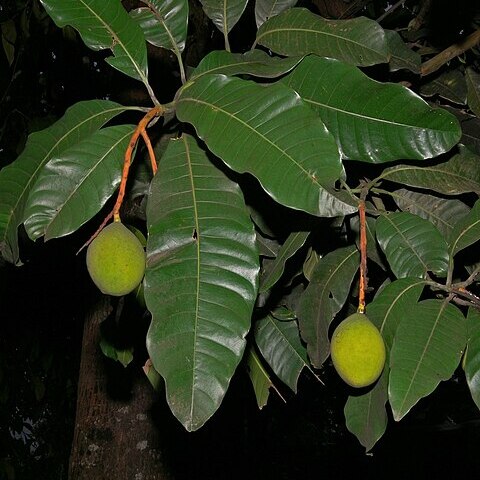Tree 7-35 m high and 20-80(-100) cm Ø. Bark grey, smooth or fissured.Leaves coriaceous, elliptic-lanceolate or lanceolate, 9-35 by 3½-10cm; base cuneate or obtuse; apex short-acuminate, or acute, rarely obtuse; nerves 15-26 pairs, prominent beneath or on both surfaces; veins reticulate, distinct on both surfaces, especially beneath; petiole 2-5(-7) cm, convex beneath, grooved above. Panicles terminal and sometimes also in the uppermost leaf axil, pyramidal, 12-50 cm long, glabrous sometimes sparsely puberulous; lateral branches up to 18 cm long, rather densely flowered; floral bracts ovate or ovate-oblong, 1-2 mm long; pedicels 1½-1¾ mm. Flowers fragrant. Calyx 5-lobed, lobes ovate, elliptic, broad-elliptic, rarely lanceolate, 2-3 mm long, glabrous, rarely puberulous outside. Petals 5, on the outside at first yellowish white, afterwards becoming red (cf. OCHSE & BAKH. l.c.), elliptic-oblong or lanceolate, 4-6 by I½-2½ mm; ridges 3(-5), c. ⅔ the length of petals, confluent at the lower ⅔. Disk pulvinate, stipe-like, c. ½ mm high, 174 mm wide, 5-lobed, not papillose. Stamens 5, 1 (rarely 2) fertile, 2-5 mm; filaments connate at the base; anthers ovoid or oblong, c. ⅔ mm long; staminodes ½-l mm. Ovary subglobose, c. 1 mm Ø; style excentric, 2½-3 mm. Sterile pistil in ♂ minute. Drupe (fresh) (OCHSE & BAKH. l.c.) dark green, obliquely ovoid or broadly ellipsoid, 10-13 by 7-10; flesh yellow, sweet, fibrous. Seed not labyrinthine.
More
A large tree. It grows to 20-27 m high. The leaves are about 25 cm long and leathery and pointed at both ends. They are carried alternately. The flowers are small and carried in compound flowers. The flowers have a strong smell. The fruit are similar to mango. It has a strong smell. It is large and oval with green skin. The fruit is 12.5 cm long by 10 cm wide. The flesh is orange and sweet. There is one seed.
Lowland mixed forest. Fl. March-Dec; fr. Sept.-Nov. In Djambi (Central Sumatra) the fruiting season is Jan.-Febr. attracting much game (pigs, elephants, etc.) to the forest, especially to the ladangs. End March RUTTEN ( Trop. Natuur 28 1939 19 fig. ) found numerous seedlings, with lilac young leaves, together with those of Durio, in the excrements of elephants.
More
A tropical plant. It grows in the lowlands. They grow in the humid tropics. It suits areas too wet for mango. It grows below 1000 m altitude in areas with a continuous rainfall. It can tolerate a range of soils. They are found in Balaebae, Zamboanga and Basilan in the Philippines.
Not known in the wild, possibly a hybrid M. foetida x M. indica.

